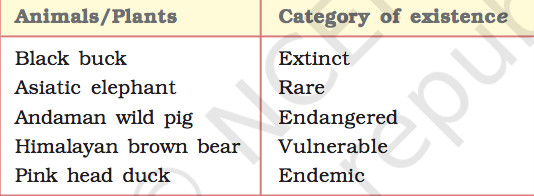Question 1. Multiple choice questions:
(i) Which of these statements is not a valid reason for the depletion of flora and fauna?
(a) Agricultural expansion
(b) Large scale developmental projects
(c) Grazing and fuel wood collection
(d) Rapid industrialisation and urbanisation
(ii) Which of the following conservation strategies do not directly involve community participation?
(a) Joint forest management
(b) Beej Bachao Andolan
(c) Chipko Movement
(d) Demarcation of wildlife sanctuaries.
Answer 1 (i) (c) Grazing and fuel wood collection
(ii) (d) Demarcation of wildlife sanctuaries.
Question 2. Match the following animals with their category of existence.

Answer 2
| Animals/Plants | Category of existence |
| Black buck | Endangered |
| Asiatic elephant | Vulnerable |
| Andaman wild pig | Endemic |
| Himalayan brown bear | Rare |
| Pink head duck | Extinct |
Question 3. Match the following

Answer 3
| Reserved forests | forests are regarded as most valuable as far as the conservation of forest and wildlife resources |
| Protected forests | forest lands are protected from any further depletion |
| Unclassed forests | other forests and wastelands belonging to both government and private individuals and communities |
Question 4. Answer the following questions in about 30 words.
(i) What is biodiversity? Why is biodiversity important for human lives?
(ii) How have human activities affected the depletion of flora and fauna?
Answer 4 (i) Biodiversity means inherited variation within species, the variety of species in an area, and the variety of habitat types within a landscape. Various organisms play different roles of producers, consumers and decomposers. It is on these roles that other organisms, including humans, depend for their existence. Humans along with the other living organisms form a complex web of ecological system in which they are only a part and very much dependent on this system for their existence. For example: the plants, animals and other micro-organisms re-create the quality of the air we breathe, the water we drink and the soil that produces our food. Forests also play a key role in the ecological system as they are the primary producers on which all other living beings depend.
(ii) Human activities have greatly affected the depletion of flora and fauna.
(a) Expansion of the commercial and scientific forestry and mining activities: Due to the expansion of the railways, agriculture, commercial and scientific forestry and mining activities Indian forests depleted to an extent.
(b) Agricultural Expansion continues to be one of the major causes of depletion of forest resources.
(c) Large-scale development projects have also contributed significantly to the loss of forests.
(d) Mining: Mining is another important factor behind deforestation. T
(e) Habitat destruction: Habitat destruction, hunting, poaching, over-exploitation, environmental pollution, poisoning and forest fires are factors, which have led to the decline in India’s biodiversity.
Question 5. Answer the following questions in about 120 words.
(i) Describe how communities have conserved and protected forests and wildlife in India.
(ii) Write a note on good practices towards conserving forest and wildlife.
Answer 5
(i) Forests in India are home to a number of communities. These communities have a complex relationship with the flora and fauna around them. In some areas of India, local communities are struggling to conserve these habitats along with government officials.
(a) In Sariska Tiger Reserve, Rajasthan, villagers have fought against mining by citing the Wildlife Protection Act.
(b) In many areas, villagers themselves are protecting habitats and openly rejecting government involvement. The inhabitants of five villages in the Alwar district of Rajasthan have declared 1,200 hectares of forest as the ‘Bhairodev Dakav Sonchuri’, declaring their own set of rules and regulations which do not allow hunting, and are protecting the wildlife against any outside encroachments.
(c) Nature worship is an age old tribal belief based on the premise that all creations of nature have to be protected. Such beliefs have preserved several virgin forests in pristine form called Sacred Groves (the forests of God and Goddesses). These patches of forest or parts of large forests have been left untouched by the local people and any interference with them is banned.
(d) Even trees are preserved in name of worship. The Mundas and the Santhals of Chhotanagpur region worship mahua and kadamba trees, and the tribals of Orissa and Bihar worship the tamarind and mango trees during weddings. To many of us, peepal and banyan trees are considered sacred.
(e) The famous Chipko Movement in the Himalayas and Joint Forest Management (JFM) programme offer good examples for involving local communities in the management and restoration of degraded forests.
(ii) (a) The famous Chipko Movement in the Himalayas has successfully resisted deforestation in several areas. It has also shown that community afforestation with indigenous species can be enormously successful.
(b) Attempts have been made to revive the traditional conservation methods. At the same time new methods of ecological farming have also been developed. Farmers and citizens groups like the ‘Beej Bachao Andolan’ in Tehri and Navdanya have shown that adequate levels of diversified crop production without the use of synthetic chemicals are possible as well economically viable.
(c) In our country Joint Forest Management (JFM) programme offers a nice example for involving local communities in the management and restoration of degraded forests.